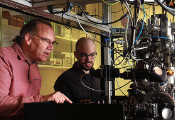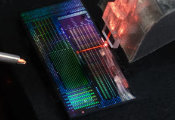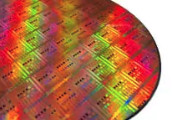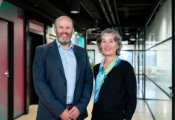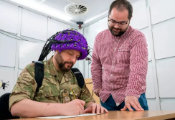Simulating the Quantum World: Purdue Researchers Get Cold With ‘Quantum Coarsening’
January 07, 2024 -- Conventional computers struggle as compared to quantum computers when examining the evolution of a network of Ising spins.
Using supercold environments and a quantum computer, Purdue researchers examined the evolution of a network of Ising spins in the presence of a transverse field. Much like ripples on water, the wave moves across the surface, but the water molecules move up and down, perpendicular to the wave's direction. This type of computational discovery is challenging with conventional or even supercomputers.
This discovery, led by Arnab Banerjee, an assistant professor at Purdue University's Department of Physics and Astronomy, has been published in Nature Communications. Banerjee also holds a guest appointment at Oak Ridge National Laboratory. Those accompanying Banerjee are Ammar Ali, PhD Candidate with Purdue Physics and Astronomy, and Hanjing Xu, graduate student in the Department of Computer Science, jointly advised by Alex Pothen, professor of computer science. The QPU experiments and analysis was facilitated by Andrew King, a Senior Distinguished Scientist at D-Wave, and one of the corresponding authors of the manuscript.
"We discovered that a particular mechanism called 'quantum coarsening' (coarsening is the same as the formation of an intricate network of magnetic domains - just like domains of "up" ↑ and "down"↓ spins in a ferromagnetic tape which helps us store and erase information) is observed when XY pseudospins derived from Ising spins are placed in a triangular motif. We capture features of the celebrated Kosterlitz-Thouless model close to its zero-temperature phase transition (named after Thouless, who won the Nobel in 2016 for the discovery of topological phase transitions)," says Banerjee. "This behavior is different from classical coarsening and percolation and overwhelms other slower mechanisms (such as the Kibble-Zurek mechanism where there forms a network of coherent excited states). We see a population of vortices and antivortices (topological defects) appearing on the D-Wave chip which obey a certain mathematical relationship ('scaling law') with how fast we 'quench' the system."

"The concept of phase transitions is a cornerstone of contemporary physics, and we are approaching an era where we can study, predict, and understand them through the lens of quantum computing," says the first author, Ammar Ali.
The company D-Wave provided the quantum computer access that the Purdue team used to make this discovery. William Bernoudy, a Principal Algorithms Researcher at D-Wave, worked on classical simulations alongside Alberto Nocera, Senior Staff Scientist, and Stewart Blusson with the Quantum Matter Institute at the University of British Columbia.
"D-Wave is a leader in quantum computing systems, software, and services focused on delivering value via practical quantum applications for problems such as logistics, artificial intelligence, materials sciences, drug discovery, scheduling, and financial modeling," says King. "As the only provider building both annealing and gate-model quantum computers, the company is unlocking commercial use cases in optimization today while building the technologies that will enable new solutions tomorrow."
The researchers at D-Wave worked with Banerjee on simulating materials with annealing quantum computers and ran cutting-edge coherent annealing experiments on the Advantage™ system. D-Wave designed and built the quantum processor and provided input on how best to use it. D-Wave and UBC researchers also provided state-of-the-art code for running classical simulations, which were used as a basis of comparison for the smallest simulations, where the classical methods are still able to keep up. The authors then went ahead to show results of a simulation which is an order of magnitude larger than the sizes of the classical method.
The findings in this research will help make specific predictions for future quantum materials. This could allow real materials, such as Ising quantum magnets using neutron scattering and magnetic measurements, such as at the National High Magnetic Field Laboratory in Los Alamos, where large magnets and generators allow split-second quantum experiments at 100 T on those real materials to search for the same phases which are predicted by the team.
"In our work, we studied two 'Ising' systems, namely the antiferromagnetic triangular and frustrated square lattice," says Banerjee. "The Villain mode, a name given to the frustrated square lattice, was first studied by J. Villain (1977). These two models are special for two reasons: they are frustrated, meaning that the interactions in the system cannot all be simultaneously satisfied, resulting in complex dynamics, and they share the same critical behavior, where critical behavior is the behavior of the model very close to its phase transition. The 3D XY model defines the universal/critical behavior of the aforementioned models."
"A simple way to understand frustration is to imagine you have a triangle where the vertices of this triangle can be in one of two states, up or down," says Banerjee. "Now your task is to align the states of these two vertices such that each two neighboring vertices are in opposite states. Thinking about this for a second, you will quickly realize that there is no configuration that can fully satisfy this task, rendering the system frustrated."
The research faced challenges since frustration required stringent calibration. "Today's qubits are not created equal which destroys frustration; thus calibrations are an essential step to make quantum computers competitive against existing classical hardware and perform coherent quantum simulations" says Hanjing Xu. However, after calibration there are strong advantages that a quantum computer can provide in simulating large quantum systems. "Exceedingly noisy quantum computers are often easy to simulate using classical computers and algorithms. But to simulate precisely the quantum state of n ~ 1296 qubits we need to keep track of 2n complex numbers on a classical computer. Even using powerful classical Tensor Networks algorithms that's not possible beyond a small n on current classical hardware", adds Alberto Nocera, research scientist at University of British Columbia, Vancouver.
Purdue University played an instrumental part in this research. The campus has a growing interest in quantum systems and computation. The university is not only a prime member of the Quantum Science Center (QSC) but also just secured an Energy Frontier Research Center (EFRC) fund on quantum, helping the quantum preparedness and productivity in the Midwest, joining hands with the Midwest Quantum Collaboratory (MQC) and Quantum Computer Emulator (QCE). Other companies recognize the value of collaboration and are eager to partner with Purdue's faculty and students to conduct innovative research and address future challenges.
Banerjee and his research team are associated with the Purdue Quantum Science and Engineering Institute (PQSEI) and also worked with the Purdue Rosen Center for Advanced Computing (RCAC) with this research. Further research down the road will connect with the upcoming Second Target Station, with the 100x beam power and 15 Hz operations, which, according to the research team, could be the perfect stage for time domain quench experiments to search for new phases of matter.
Funding for this research project was provided in part by the Center for Quantum Technologies (NSF-IUCRC), the Quantum Science Center (DOE-NQI managed by ORNL).


